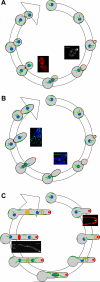Morphogenesis and cell cycle progression in Candida albicans
- PMID: 17055773
- PMCID: PMC3552184
- DOI: 10.1016/j.mib.2006.10.007
Morphogenesis and cell cycle progression in Candida albicans
Abstract
Candida albicans, an opportunistic human pathogen, displays three modes of growth: yeast, pseudohyphae and true hyphae, all of which differ both in morphology and in aspects of cell cycle progression. In particular, in hyphal cells, polarized growth becomes uncoupled from other cell cycle events. Yeast or pseudohyphae that undergo a cell cycle delay also exhibit polarized growth, independent of cell cycle progression. The Spitzenkörper, an organelle composed of vesicles associated with hyphal tips, directs continuous hyphal elongation in filamentous fungal species and also in C. albicans hyphae. A polarisome mediates cell cycle dependent growth in yeast and pseudohyphae. Regulation of morphogenesis and cell cycle progression is dependent upon specific cyclins, all of which affect morphogenesis and some of which function specifically in yeast or hyphal cells. Future work will probably focus on the cell cycle checkpoints involved in connecting morphogenesis to cell cycle progression.
Figures




References
-
- Gow N, Brown A, Odds F. Fungal morphogenesis and host invasion. Curr Opin Microbiol. 2002;5:366. - PubMed
-
- Wightman R, Bates S, Amornrrattanapan P, Sudbery P. In Candida albicans, the Nim1 kinases Gin4 and Hsl1 negatively regulate pseudohypha formation and Gin4 also controls septin organization. J Cell Biol. 2004;164:581–591. - PMC - PubMed
-
•This paper describes kinases that act at the septin ring and affect morphogenesis. It also shows that gin4Δ/Δ cells, which are pseudohyphal, cannot form hyphae, while Gin4p-depleted cells, which start in the yeast form, can form hyphae.
-
- Lew DJ, Reed SI. Cell cycle control of morphogenesis in budding yeast. Curr Opin Genet Dev. 1995;5:17–23. - PubMed
-
- Crampin H, Finley KR, Gerami-Nejad M, Court H, Gale CA, Berman J, Sudbery PE. Candida albicans hyphae have a Spitzenkörper that is distinct from the polarisome found in yeast and pseudohyphae. J. Cell Sci. 2005;118:2935–2947. - PubMed
-
••This manuscript demonstrates that C. albicans hyphae have a Spitzenörper in addition to a polarisome and that it persists throughout hyphal growth. It shows that components of polarisomes are found primarily in the Spitzenkörper (Mlc1p and Bni1p), while others (Spa2p, Bud6p and Cdc43p) are primarily found in the polarisome.
Publication types
MeSH terms
Substances
Grants and funding
LinkOut - more resources
Full Text Sources

